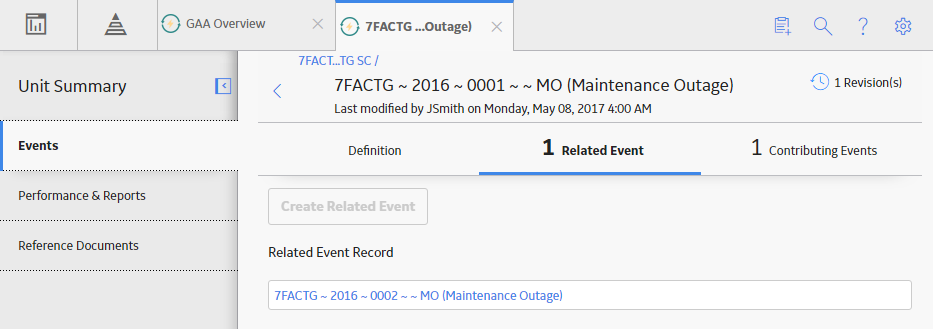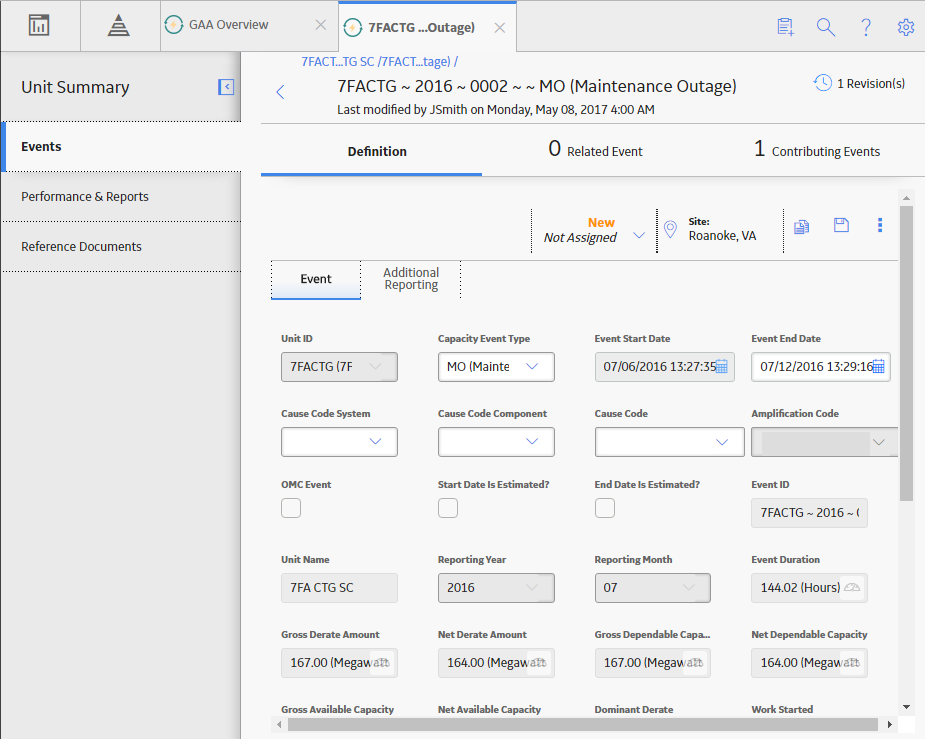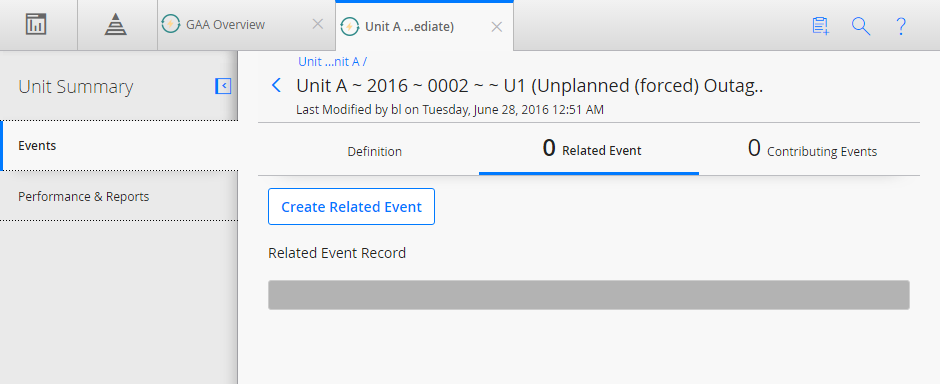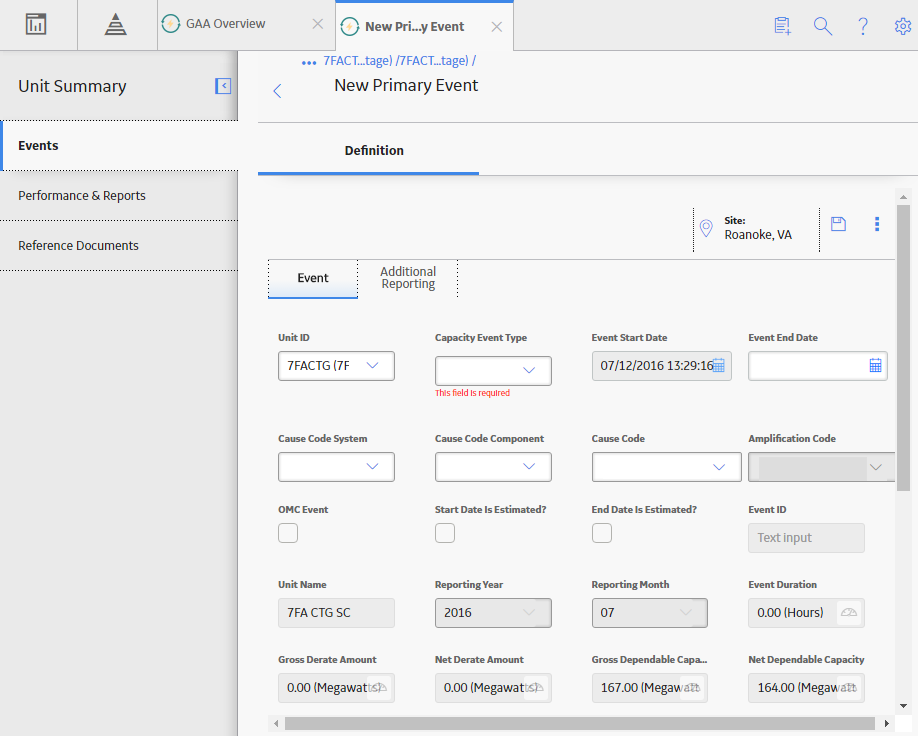Related Events
About Related Events
Sometimes, one event will directly follow another event, where each event is represented by a separate Primary Event. There is no limit to the chain of subsequent events that may occur, each of which will be represented by its own Primary Event. In this documentation, we refer to two Primary Events that represent two related events as related Primary Events. A chain of sequential events can be represented by multiple sequential Primary Event pairs.
The GE Digital APM system determines that two Primary Events represent related events when the value in the Event Start Date field in a new Primary Event matches the value in the Event End Date field of an existing Primary Event that is linked to the same GAA Unit. In this case, the value in the Capacity Event Type field in the subsequent event can contain only certain values, depending on the value in the Capacity Event Type field in the preceding event.
When creating a subsequent Primary Event, if you select a Capacity Event Type value that is not listed as an allowable event type in the subsequent Event and you specify a value in the Cause Code field, a warning message appears, explaining that you have selected an invalid scenario that follows an existing Primary Event.
Access a Related Event
Procedure
Create a Related Event
Before you begin
- Create a Primary Event.
- The Primary Event must have a value in the Event End Date field.
- The Primary Event must not have another Related Event.
Procedure
Example
Consider an example of GAA Unit A, represented by the GAA Unit record GAA Unit A. On January 3, 2016, GAA Unit A suffered an unplanned outage due to an external influence and had to be repaired before it could be used again. Repairs began at 9:00 A.M. on January 5 and continued until 5:00 P.M., when it was determined that a new part had to be ordered to complete the repairs. The new part arrived on January 8, and the repairs were finished by 5:00 P.M. on January 8.
In this scenario, you would have needed to create three Primary Events:
- One to capture the initial outage.
- One to capture the maintenance.
- One to capture the extended maintenance due to other circumstances.
Consider the following table, where each column represents an Event that you would have created in this scenario.
|
Fields |
Primary Event 1 |
Primary Event 2 |
Primary Event 3 |
|---|---|---|---|
|
Capacity Event Type |
U1 (Unplanned (forced) Outage - Immediate) |
MO (Maintenance Outage) | ME (Maintenance Outage Extension) |
| Event Start Date | January 3, 2016, 9:00 A.M. | January 5, 2016, 9:00 A.M. | January 5, 2016, 5:00 P.M. |
| Event End Date | January 5, 2016, 9:00 A.M. | January 5, 2016, 5:00 P.M. |
January 8, 2016, 5:00 P.M. |
In this example, you would have created two sequential Primary Event pairs:
- Pair 1: Primary Event 1 + Primary Event 2.
- Pair 2: Primary Event 2 + Primary Event 3.
None of these Primary Events can stand alone because none of them describes completely what happened to GAA Unit A.
- Primary Event 1 indicates that the unit was out during the time between when it stopped producing power and repairs began. By itself, it would not indicate that any repairs were attempted on the unit.
- Primary Event 2 indicates that repairs on the unit began at 9:00 A.M. on January 5, 2016 and ended at 5:00 P.M. the same day. By itself, it neither indicates that the unit had stopped producing power before the repairs began nor that maintenance was extended to account for the time it takes to order and receive a new part. The Capacity Event Type value for Primary Event 2 is MO, which is a valid event type for subsequent events of type U1, as defined in Primary Event 1.
- Primary Event 3 indicates that maintenance was extended but does not indicate when repairs began on the unit or that it had stopped producing power before the repairs began. The Capacity Event Type value for Primary Event 3 is ME, which is a valid event type for subsequent events of type MO, as defined in Primary Event 2.


 to save your changes.
to save your changes. 
